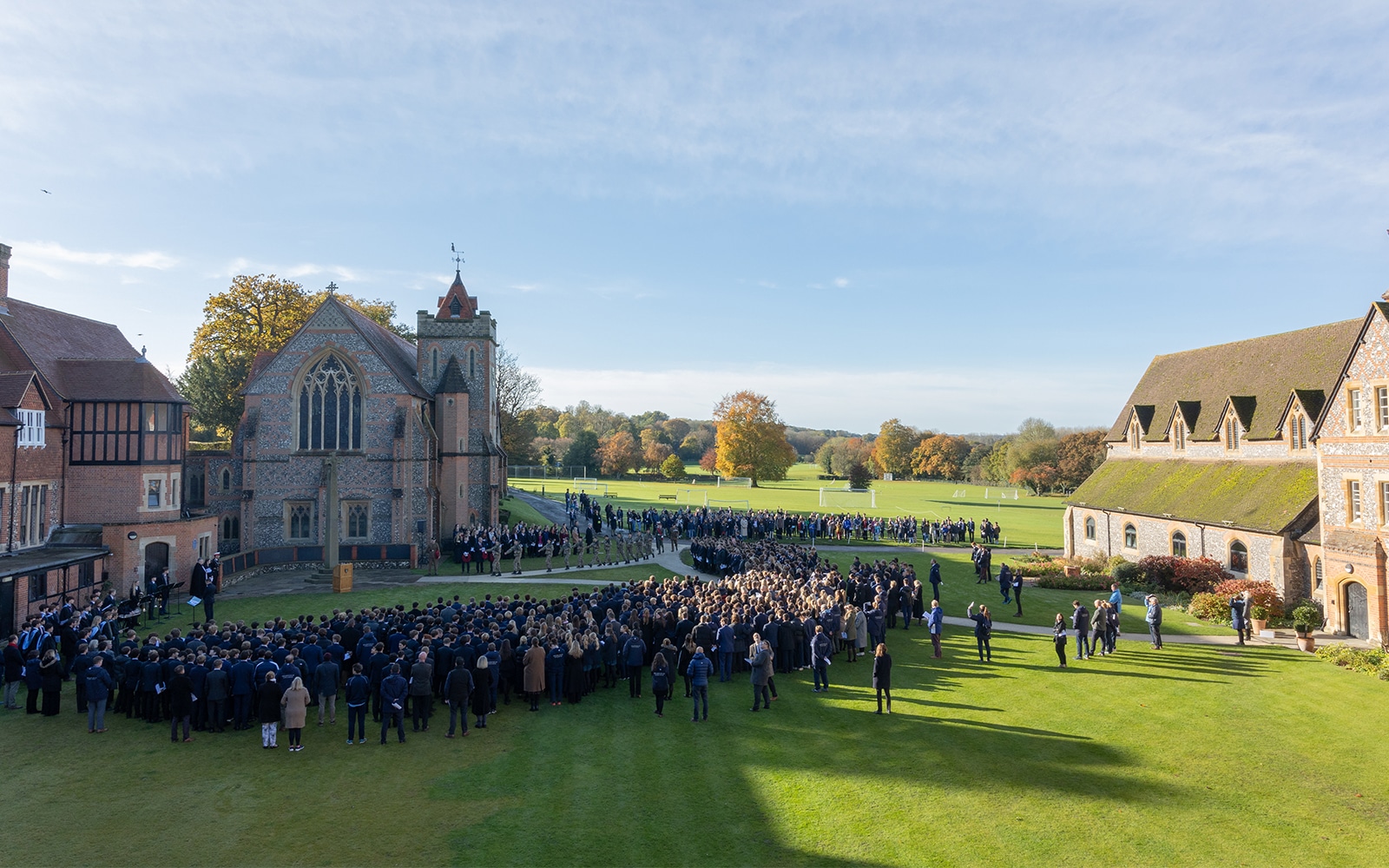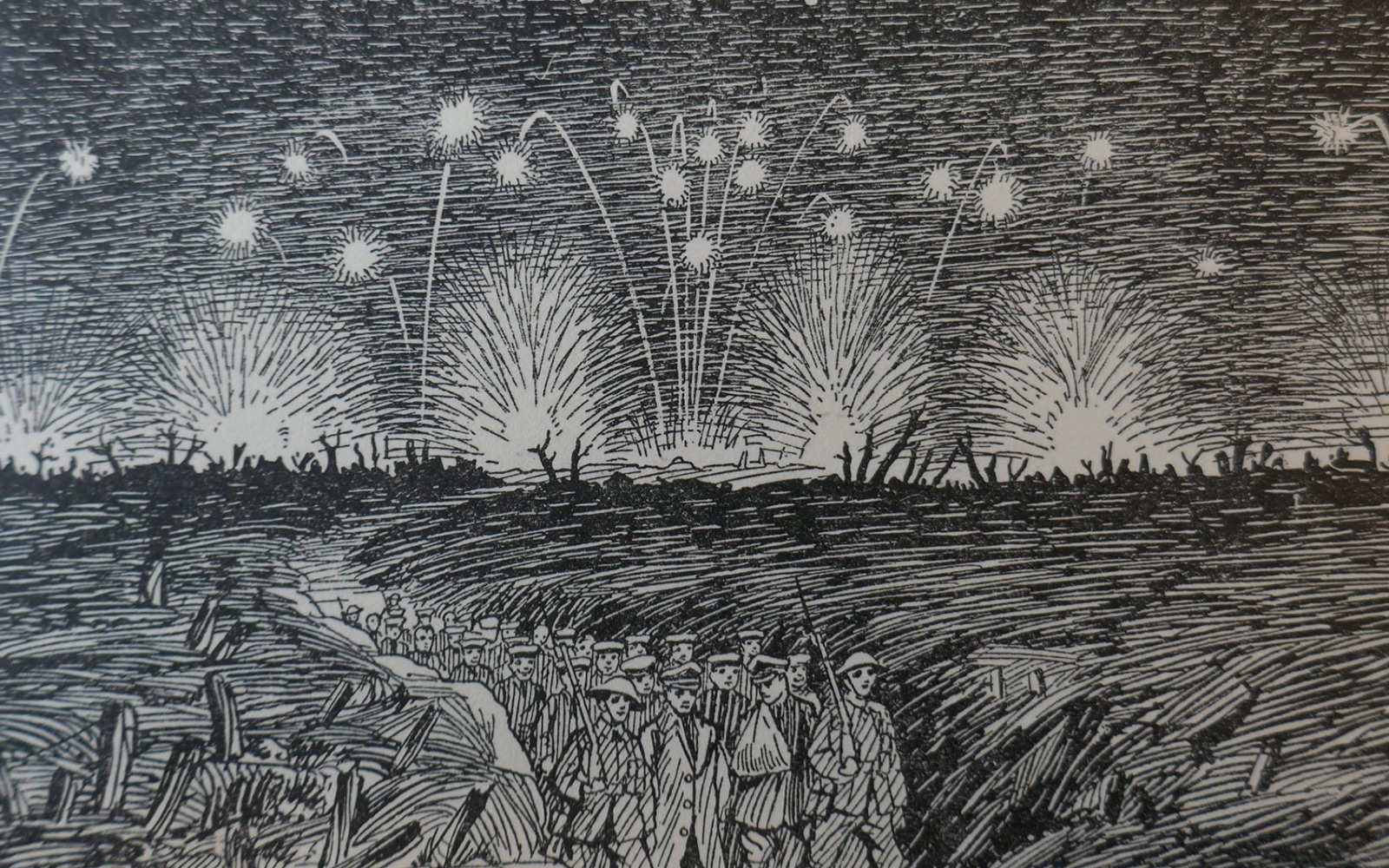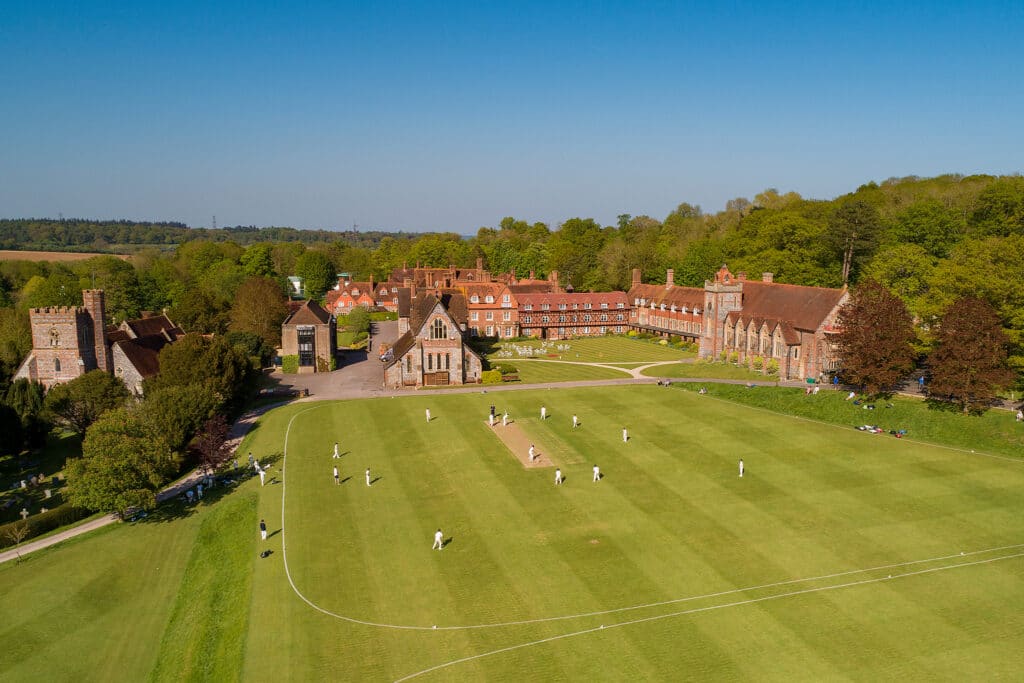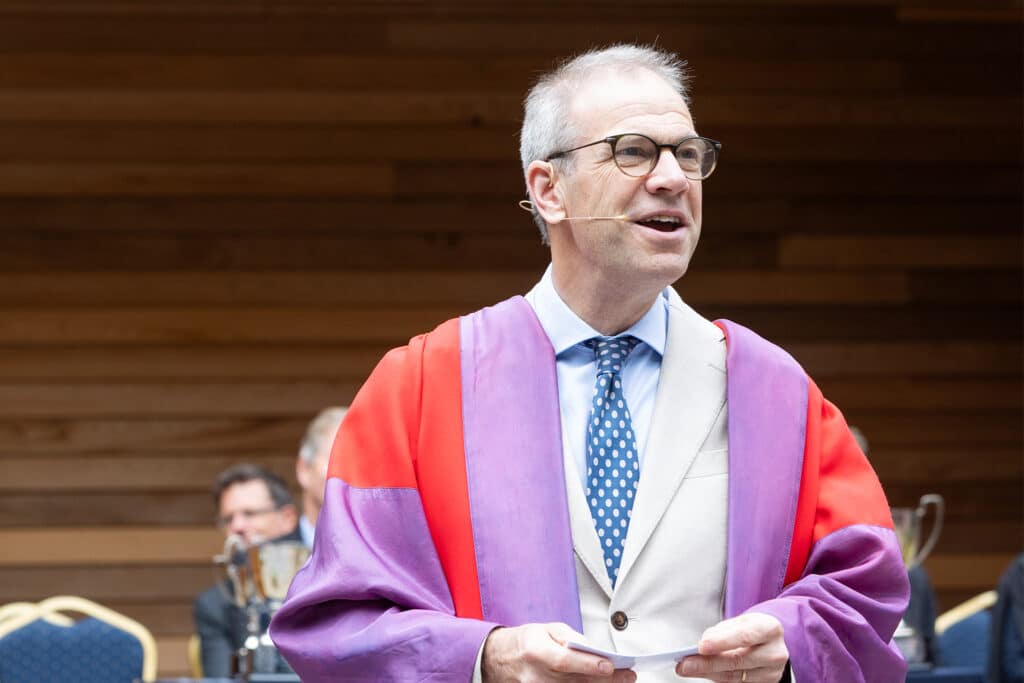
At the close of the nineteenth century Bradfield was a much smaller school which offered a classical curriculum for the pupils housed in the main College buildings, an ‘army class’ which prepared pupils for military service and a ‘navy class’ based in the recently-built House-on-the-Hill. Within twenty years 279 pupils of that generation had lost their lives in the First World War. A further 198 Bradfieldians lost their lives during the Second World War and two have died in Wars since 1945.
On the 11th hour of the 11th day of the 11th month, Bradfield remembered them during an Armistice Day service in front of the Bradfield War Memorials. Bradfield pupils, staff and guests gathered in Quad to pay their respects as representatives of the Bradfield community laid wreaths at the foot of the memorials. The Headmaster addressed the school prior to the playing of The Last Post and two-minute silence and you can read his reflection below.
The following day the College hosted a Remembrance Sunday service in Chapel. To open the service, current pupils read out the names from the Roll of Honour, paying tribute to the former pupils who lost their lives during the Wars. We welcomed back Old Bradfieldian and Royal Marine Dom Rogers (D 96-01) to give the address, during which he remembered his former Head of House John Sanderson (D 94-99) who died during deployment in Afghanistan in 2010. You can also read his address below alongside a short article on the impact of the First World War on The Bradfield Club in Peckham, researched and written by College Archivist John Cardwell.
Headmaster’s Remembrance Reflection
The Collingwood Cross was erected as a memorial in November 1916, on the other side of Quad outside Big School. Initially it bore some 159 names and the simple inscription, ‘Pro deo et patria’, ‘for God and Country’. The Chief of the Imperial General Staff visited Bradfield for its dedication ceremony and commended the service of public schoolboys in a speech widely reported in the national press. By the end of the war a further 120 names needed to be added to the base.
The memorial was moved to its current location in 1951 in order to accommodate the slate tablets behind it which record the names of some 200 more Old Bradfieldians who lost their lives in the Second World War.
Large memorials and gleaming white headstones now welcome visitors to the war cemeteries of France. But a century ago, these soldiers’ graves were marked with simple wooden crosses. During the war, soldiers were typically buried where they fell or close by. Such was the scale of the killing that many crosses were made in the field by comrades, often from scrap wood or old packing crates.
When those temporary wooden crosses were replaced by permanent stone memorials after the war, soldiers’ families were given the opportunity to keep the originals. Some 16 such crosses were given to the College for safe-keeping and they have been on display since 2018 in the cloisters leading up to Chapel at the end of bloods passage.
This is the humblest of those crosses, made of two rough planks held together by four handmade nails. Its rustic simplicity is strangely moving. It has even lost its name plate and can therefore represent all the Bradfieldians that we remember and honour today.
This physical object brought back from the battlefield helps us to connect with those men in a personal way. It reminds us not only of lives cut short but of the impact upon those who survived, upon those who knew them, and those who loved them. It reminds us of the families and the communities who received these crosses of remembrance and held them dear.
For the bodies whose graves were first marked by crosses such as these, for the Bradfieldians remembered on this double memorial and for their families, their friends and their teachers, the symbol of the cross speaks of the self-sacrifice of a generation by recalling the sacrifice of Jesus Christ.
The cross reminds us not just of the Crucifixion of Jesus, however, but also of the salvation offered to us through his passion and death. The cross is a symbol both of sacrifice and of hope in resurrection.
This wooden cross once physically marked the mortal remains of a person who lived and learned where we stand today. Much more importantly, it also represents the faith that he and his comrades now rest in an eternal home.
At this time, the pity of war is acutely felt by many communities across the world. In several countries peace seems simultaneously more distant and more important than ever. We therefore continue to pray for those who die, for those who suffer, for those who weep, and for those who mourn amidst chaos and confusion. Above all, we pray for peace.
Dom Rogers (D 96-01) Remembrance Address
On a wall of a building in a Forward Operating Base I served in in Sangin, Afghanistan, was daubed the following, paraphrasing from Theodore Roosevelt:
“It’s not the critic who counts; not the man who points out how the strong man stumbles, or where the doer of deeds could have done them better. The credit belongs to the man who is actually in the arena, whose face is marred by dust and sweat and blood…
… who at the best knows in the end the triumph of high achievement, and who at the worst, if he fails, at least fails while daring greatly.”
Today is a day of Remembrance and thanksgiving for all those who have been involved in war, all those who have been in the arena. Of course we think of World War I, thought of as the war to end all wars, then World War II, the last time when total war threatened the freedom of our Island nation. But we also think of many conflicts since which have claimed the lives or injured so many.
As we gather here in the Chapel, this sanctuary at the heart of the College, we remember in particular the members of this special community who served, did their duty, and paid the ultimate price, whose names are recorded in the roll of honour that was read out this morning. And many of us will also remember family, friends or colleagues. This being the first time I have been here for a Remembrance Service since I left in 2001, I remember in particular my old Head of House John Sanderson, who lost his life in Afghanistan the same summer I was deployed there, with a feeling that there but for the grace of God go I.
But war is never pleasant or glamorous. It’s nature is violent, cruel, unfair, ghastly. No matter how lofty and just the cause of conflict may be. The battlefield and the era may change: but the mud, the dust, the noise, the smell, the blood, the chaos, the chance, the gripping chill of fear, the little surge of adrenaline from which courage may flow, the hope – these never change. Much of this was captured in the words of the great war poets, whom I first remember studying in the classrooms above Bloods. I think it was Wilfred Owen who said that his subject was war and the pity of war – the poetry was in the pity.
It is still absolutely right we remember all those who have served, on land, in the air and at sea. We remember those who have given their lives in defence of our nation and our freedom.
We remember those whose lives were permanently scarred because of injury, both physical and mental. We remember the civilian services: the police, fire and rescue, and ambulance and other agencies – their heroic work in often very tough conditions at home or overseas.
And we remember the families who see their loved ones deploy and can suffer the pain of separation and risk the pain of loss. Something I am more acutely aware of having seen my own wife deploy ‘down range’ as we say.
We remember because to forget would be to both dishonour those who served and it would be to fail to learn anything from such past conflicts or understand the costs involved in having a free society today.
I call to mind the words of an American soldier 1 and writer that I was recently introduced to:
It is the Soldier, not the reporter
Who has given us the freedom of the press.
It is the Soldier, not the poet
Who has given us the freedom of speech.
It is the Soldier, not the peace camp organiser
Who has given us the freedom to demonstrate.
It is the Soldier, who serves beneath the Flag
whose coffin is draped by the Flag
who allows the protester to burn the Flag.
It is the Soldier, not the politician
Who has given his blood
his body
his life
The Soldier, who has given these freedoms.
So today, Remembrance Sunday we gather as we do every year. And we will go out from here to lay wreaths of poppies with quiet contemplation and not pride as we remember poppies that grew in Flanders Fields, and, for my generation of service men and women, we can’t help remembering a different kind of poppy that grew in the fields of Helmand Province.
For it is not a time to glorify war. If ever we take up arms we should do so in sorrow not anger and if we are victorious in war there should be no rejoicing, only bitter regret that such a costly victory be called for. Because while there is a time for war – there is also a time for peace.
And while the ultimate peace and justice and joy will come only at the end of time in the Kingdom of God. That doesn’t mean that we sit back and wait. Now we must be working for peace.
In the words of Mahatma Ghandi – although Google suggests it may be John Lennon.
“Peace is not something that you wish for. It is something that you make,
something that you do, something that you are, something that you give away.”
If we really want to honour those who died in war, then we must set ourselves the task of building a more peaceful loving world for the generations to come, and down which ever path our feet take us in the future, whether in the service of a nation, or in the service of a community, or in the service of our family and friends.
I am no theologian, but I believe the gospel is a call to change from thinking about ourselves, and a call to sacrificial living for others as a way of demonstrating our love for God.
Jesus went to great lengths to show that this was something to which every person was called.
Everybody has a talents and gifts which are to be used by God and not just buried away.
So as we Remember our fallen, or fellow Bradfieldians, let us pledge ourselves to work for peace and pray that one day our world will be a place where there is no fighting and unrest, where all people will live together in peace and respect and be grateful to all who have given their lives in the service of peace.
“May the angles lead them into paradise.”
1 Charles Province.
Bradfield Remembers: The Bradfield Club and the First World War

Christmas Card, 1916, from Richard Hayward to St Luke’s, Peckham
As Bradfield remembers its former pupils who lost their lives in the World Wars, it is also important to mark the sacrifice of the many young men of the Bradfield Club in Peckham, who served during the First World War. As part of a broader drive by British public schools to improve the lives of the poor and promote the spread of Christianity, in 1912 Bradfield took over the running of the Working Lads’ Club in the Anglican parish of St Luke’s, Peckham. It continues to thrive today as The Bradfield Club.
The outbreak of the First World War dramatically affected the operation of the club. Reflecting the powerful influence of nationalism in contemporary Europe, a strong patriotic spirit had infused all its activities. This was fostered by two of the club’s most inspiring leaders, its founder and manager Richard Frederick Hayward and Edward H. Clarke, its gymnastics instructor, who was idolised by the older boys. Hayward had entered the Merchant Navy in the 1890s and became a lieutenant in the Royal Naval Reserve in 1904, before being called to the Bar in 1908 and working as a maritime lawyer. He was commissioned in the 22nd Battalion of the County of London Regiment (Territorial Army) in 1912 and served in its machine gun section. ‘Realising the need of attracting the older lads in the home defence of their country’ and hoping to prepare those who might be caught up in a future conflict by some military experience, he encouraged club members to enlist, and by 4 August 1914 ‘all the machine-gunners in my Battalion, except the NCOs were lads from the Bradfield Boys’ Club’. Clarke, who had been born and bred in St Luke’s, and had assisted with the original Working Lads’ Club, also joined the regiment, becoming a sergeant and its gymnastics instructor.
With the onset of war, Hayward initially was medically unfit for general service and became a machine gun instructor, before being posted to France in 1916 with the Machine Guns Corps. Clarke and the Bradfield Club boys volunteered for overseas service with the 22nd Battalion and were deployed to Givenchy in April 1915. Almost immediately they raised a board above their trench inscribed ‘Play up Brads’. This expression of esprit de corps, courage and determination was later adopted as the club motto. Other members of staff volunteered, and the club’s Warden, Rev. John Douglas, estimated that in total more than 400 club boys served in the armed forces during the conflict. They fought in many theatres of war, including Greece, Mesopotamia and Egypt as well as in Flanders and France. One club member was discharged from the army in France in 1915 when it was discovered that he was only 16½ years old. Tragically, one of the first fatalities was Clarke, killed in May 1915 by an exploding shell while assisting a stretcher party. One of his former gym squad wrote that characteristically, ‘He died like a hero, helping the wounded.’ Another much lamented loss among the staff was Old Bradfieldian Ronald Young Herbert of the Royal Field Artillery, who had introduced chess into the club; he was killed in September 1917. Five assistant scoutmasters lost their lives. Although the majority of club boys served in the army, there was a strong naval presence, including two seamen who died when the cruiser HMS Black Prince was sunk at the Battle of Jutland in 1916.
At the end of the war, the club’s known fatalities numbered 74, although Douglas believed that the true figure was nearly 100. Ronald Herbert’s brother Robert was also killed in action. Their father, the solicitor Edward Herbert, whose five sons and four grandsons attended Bradfield, later purchased 5 Commercial Road, Peckham, and presented it to the club as a memorial to Old Bradfieldians and club members who died in the First World War. A poignant collection of wartime postcards that were sent home to Douglas by club boys, some containing portrait photographs, is preserved among St Luke’s parish records in the London Metropolitan Archives.
We are very grateful to St Luke’s, Peckham, for permission to publish images from its archives.



